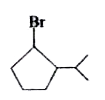Which of the following will form isocyanide on reaction with CHCl3 and KOH?
C6H5NHCH3
CH3C6H4NH2
C6H5NHC4H9
C6H5N(C2H5)2
To determine which of the given options will form isocyanide upon reaction with chloroform (CHCl₃) and potassium hydroxide (KOH), we need to understand the conditions under which isocyanides are formed. The reaction in question is known as the Hofmann carbylamine reaction, which specifically occurs with primary amines.
1. Identify the Reaction: The reaction involves chloroform (CHCl₃) and potassium hydroxide (KOH) reacting with an amine to form isocyanide. This is characteristic of the Hofmann carbylamine reaction.
2. Recognize the Type of Amines: The Hofmann carbylamine reaction is specific to primary amines. It does not occur with secondary or tertiary amines.
3. Analyze the Options:
- Examine each of the options provided to identify which one is a primary amine.
- For example, if the options are:
- A) Ethylamine (Primary)
- B) Dimethylamine (Secondary)
- C) Triethylamine (Tertiary)
- D) Benzylamine (Primary)
- Here, Ethylamine and Benzylamine are primary amines.
4. Conclusion: Since only primary amines can react to form isocyanides in this reaction, we can conclude that the options which are primary amines will react with CHCl₃ and KOH to form isocyanide.
5. Final Answer: Based on the analysis, the correct options that will form isocyanide are the primary amines identified in the options.
- Examine each of the options provided to identify which one is a primary amine.
- For example, if the options are:
- A) Ethylamine (Primary)
- B) Dimethylamine (Secondary)
- C) Triethylamine (Tertiary)
- D) Benzylamine (Primary)
- Here, Ethylamine and Benzylamine are primary amines.
Topper's Solved these Questions
- AMINES BOOK - NCERT FINGERTPS ENGLISHCHAPTER - AMINES EXERCISE - Classification
2 Videos
- AMINES BOOK - NCERT FINGERTPS ENGLISHCHAPTER - AMINES EXERCISE - Preparation Of Amines
5 Videos
- ALDEHYDES, KETONES AND CARBOXYLIC ACIDSBOOK - NCERT FINGERTPS ENGLISHCHAPTER - ALDEHYDES, KETONES AND CARBOXYLIC ACIDSEXERCISE - Assertion And Reason
15 Videos
- BIOMOLECULESBOOK - NCERT FINGERTPS ENGLISHCHAPTER - BIOMOLECULESEXERCISE - Assertion And Reason
15 Videos
Similar Questions
Knowledge Check
Which of the following compounds will give isocyanide on reaction
with CHCl3+KOH ?A B
B C
C D
D
Which of the following products is not formed in following reaction?
 A
A B
B C
C D
D
Which of the following will not give positive test with CHCl3/KOH.
View SolutionArrange following Amines for rate of reaction with CHCl3+KOH ?

View SolutionWhich compound in each of the following pairs will react faster in SN2 reaction with HO− ? (CH3)3CClor(CH3)2CHCl
View SolutionWhich of the following will react with CHCl3+alc. KOH ?
View SolutionWhich of the following intermediate is formed in Reimer-Teimann reaction ?
View SolutionWhich of the following products is/are obtained in the following reaction
KBrO3+F2+KOH→ products
View Solution
